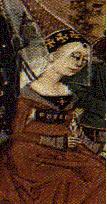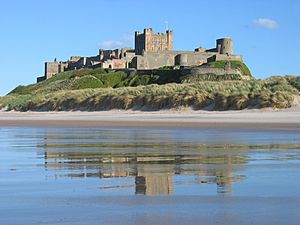Isabella de Beaumont facts for kids
Quick facts for kids Isabella de Beaumont |
|
|---|---|
| Spouse(s) | John, Baron de Vesci |
| Noble family | de Beaumont de Vesci |
| Father | Sir Louis de Brienne |
| Mother | Agnés de Beaumont, Vicomte of Beaumont |
| Born | circa 1260 |
| Died | 1334 |
| Occupation | Lady-in-waiting to Eleanor of Castile and Isabella of France. |
Isabella de Beaumont (died 1334) was an important noblewoman in medieval England. She was a close friend and supporter of Isabella of France, who was the Queen to Edward II of England. Isabella de Beaumont played a big role in the politics of her time.
Contents
Isabella's Early Life and Marriage
Isabella de Beaumont was born around the 1260s. Her father was Sir Louis de Brienne, and her mother was Agnés de Beaumont. The de Beaumont family was very powerful and had roots in France. Isabella was also related to many important European royal families. For example, she was a cousin to Eleanor of Castile, who was the wife of King Edward I. This meant Isabella was very well-connected across Europe.
Isabella came to England in 1278 or 1279. She married John de Vesci, a powerful English noble, around 1279 or 1280. King Edward I approved of this marriage. It was a good match for John de Vesci. It also helped Isabella become an important person at the English royal court. John de Vesci was a close friend of both King Henry III and King Edward I.
Isabella continued to be favored by the king. For her wedding, King Edward gave her valuable lands to own herself. In 1288, Isabella and her husband traveled to Gascony in France. King Edward arranged for them to have special rooms next to his own. He even had them decorated for Christmas. Isabella was one of Queen Eleanor's closest friends until the Queen died in 1290.
Isabella de Beaumont was also given a very unusual job for a woman of her time. She became the governor of two royal castles: Scarborough Castle in Yorkshire and Bamburgh Castle in Northumberland. Bamburgh was her main base of power. This job was given to her because King Edward trusted her loyalty. She could keep this job as long as she remained unmarried.
John de Vesci died in 1289. After his death, Isabella became a major landowner in England. Her lands stretched from Scotland all the way to Kent. She became the most important member of the Beaumont/Vescy family. In 1300, Isabella's brother, Henry de Beaumont, came to England. Isabella convinced the king to give him lands that had belonged to her late husband. Isabella also helped arrange Henry's marriage. This marriage helped Henry inherit an earldom and many properties in Scotland. The de Beaumont family owned many properties in Scotland. This would become important later on.
Isabella Under Edward II

After King Edward I died in 1307, Isabella and her brother Henry became important at the court of Edward II of England. Isabella de Beaumont became a lady-in-waiting and a close friend to the young Isabella of France. Queen Isabella had come from France to marry Edward in 1308. The two Isabellas often wrote letters to each other when they were apart. Isabella de Beaumont, like other members of the Queen's court, had duties in other parts of the kingdom.
Isabella de Beaumont was involved in many important political events. The early years of Edward II's reign were full of tension. There were many different groups of powerful nobles in England. King Edward was very close to his favorite, Piers Gaveston. At first, Queen Isabella supported Gaveston. Opposing the king was a group of powerful nobles led by Thomas of Lancaster.
The de Beaumonts were allied with Queen Isabella. Lancaster saw Isabella and Henry as new people who had gained wealth and power because the king favored them. He also disliked Isabella's friendship with his father-in-law. Because of this, when the Lancastrians passed the Ordinances of 1311, Isabella and her brother were sent away from court. Isabella was accused of giving "bad advice" and getting special favors for her friends. She went back to her home in Yorkshire for a short time.
Some nobles tried to remove Isabella from her job at Bamburgh castle. King Edward II told her to delay as long as possible. Isabella held on to the castle. She finally agreed to give it up in exchange for lands in Lincolnshire and Dorset. Even then, she gave the castle to one of the king's clerks, not to a noble. Isabella de Beaumont soon found a way to return to court in 1313. She helped overturn the ordinances. In the following years, Isabella and Henry relied more and more on Queen Isabella for help. In return, they supported her politically. The Queen sent Isabella many gifts, including cheese and wild boar meat. Isabella also went with the King and Queen on trips to France.
Through the Queen, Isabella helped one of her other brothers, Louis de Beaumont, become the Bishop of Durham in 1317. Louis was also against the Lancastrians. He promised the king he would be a "stone wall" against any Scottish invasion.
Isabella and the Despensers
After 1322, King Edward II had defeated the Lancastrian nobles. His new favorite, Hugh Despenser the Younger, had taken the place of Piers Gaveston. However, King Edward and Queen Isabella became more and more divided. Things got worse after Edward's failed invasion of Scotland. Queen Isabella was left behind and almost captured by the Scots.
Queen Isabella blamed Edward and the Despensers for this. The king blamed Louis de Beaumont, whose "stone wall" against the Scots had not worked. Isabella de Beaumont, as Louis's sister and a close friend of Queen Isabella, lost the king's favor. Both Queen Isabella and the de Beaumonts quickly found themselves on the wrong side of the Despensers' harsh rule. Isabella was seen as a "silent partner" in Queen Isabella's growing anger towards the king.
By 1326, Queen Isabella was desperate. She left for Paris, saying she was going for talks about Gascony. But she was really planning a rebellion against Edward and the Despensers. Meanwhile, Isabella de Beaumont and Henry had openly turned against King Edward. Royal officials were being attacked by their forces in Yorkshire. Queen Isabella invaded England soon after, with her supporter, Roger de Mortimer. They removed Edward from power. The de Vesci family now hoped to be favored by the new court again.
Isabella and the Fall of Queen Isabella
One big challenge for Queen Isabella's new government was the wars with Scotland. England could not easily afford to keep fighting. But making peace with Scotland could mean that English landowners in the north would lose their properties. Queen Isabella and Mortimer chose to make peace. As a result, families like the Beaumonts lost a lot of land. This ended Isabella's friendship with Queen Isabella. Isabella and Henry broke away from the new court. They became part of the group that opposed the Queen.
In 1330, Edmund of Kent tried to start an uprising against Queen Isabella. He wanted to bring back Edward II, who many believed was still alive. Isabella played a key part in this plan. She used her confessor (a priest she told her sins to) to send messages between Edmund and the archbishop of York. Queen Isabella and Mortimer found out about the plot. They executed Edmund, but Isabella herself was not arrested.
Later that year, Edward III overthrew Mortimer. Isabella de Beaumont found herself back in royal favor for the last few years of her life. She received more lands in North Wales. Isabella died in 1334 without any children. She was buried at the Black Friars abbey in Scarborough. Her brother Henry inherited her lands.


